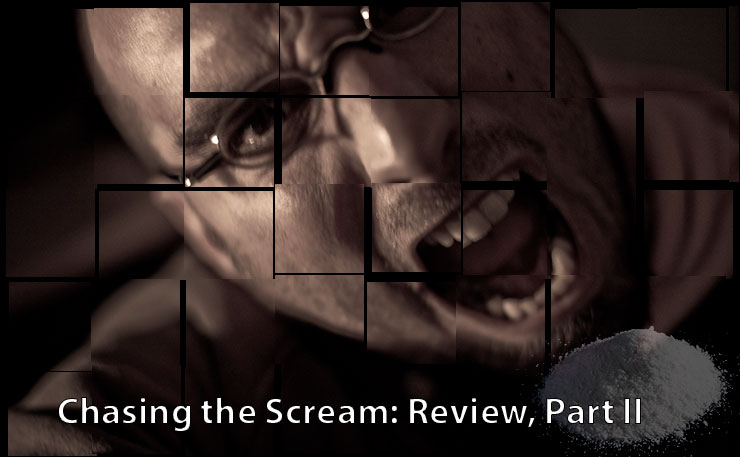This is the second in a four part New Matilda series by Michael Brull, reviewing Chasing the Scream, a book by journalist Johann Hari that examines the ‘War on Drugs’. In this article, Brull looks at theories around addiction, and whether or not drugs really do ‘hook’ users in.
Another major issue that Hari addresses in Chasing the Scream is the question of how addiction actually works. Just as other chapters are peppered with anecdotes, so Hari’s arguments are based more on stories and individual experiments than a systematic review of what the scientific literature on drugs shows.
Yet some of the points Hari makes are pretty strong.
Hari is particularly concerned with refuting the argument that people become addicted to drugs purely because of chemical hooks within them. This is the theory that drugs are naturally addictive, because of their physical properties.
A person can try this or that drug, and will instantly become addicted, because of those physical properties. We might call this the model of chemical addiction.
An experiment on rats performed decades ago was thought to confirm this model. They put a “rat alone in a cage” and gave it “unlimited quantities of cocaine… nine times out of 10, it will use so much and so compulsively that it will kill itself.”
Hari challenges this in a few ways. For example, he cites statistics showing that most people use drugs without getting addicted. According to Carl Hart, “of the people who have tried crack, just 3 per cent have used it in the past month, and at most 20 per cent were ever addicted at any point in their lives.”
Hari also writes that, “Only 10 per cent of drug users have a problem with their substance. Some 90 per cent of people who use a drug – the overwhelming majority – are not harmed by it. This figure comes not from a pro-legalisation group, but from the United Nations Office on Drug Control, the global coordinator of the drug war. Even William Bennett, the most aggressive drug czar in US history, admits: ‘Non-addicted users still comprise the vast bulk of our drug-involved population.’”
Similarly, the World Health Organisation reportedly conducted a “massive scientific study” of cocaine in 1995. It found that “experimental and occasional use are by far the most common types of use, and compulsive/dysfunctional [use]is far less common.”
The fact that so many people can use drugs recreationally without getting addicted suggests that the chemical model, at the very least, is simplistic.
Hari advances a different model of addiction through the work of two researchers in particular, Gabor Mate and Bruce Alexander.
Gabor Mate: Susceptibility to drug use from childhood trauma
Mate’s position is that “nothing is addictive in itself. It’s always a combination of a potentially addictive substance or behaviour and a susceptible individual. So the question we need to keep asking is – what creates the susceptibility?”
Hari cites some of the studies that Mate cites. For example, one study looked into the “long-term effects of early childhood trauma”. Hari writes that, “These scientists discovered that for each traumatic event that happened to a child, they were two to four times more likely to grow up to be an addicted adult. Nearly two-thirds of injection drug use, they found, is the product of childhood trauma. This is a correlation so strong that scientists said it is ‘of an order of magnitude rarely seen in epidemiology or public health.’ It means that child abuse is as likely to cause drug addiction as obesity is to cause heart disease.”
Another long-term study found similar results. It followed children “from the age of five until they were eighteen, to figure out how much the quality of your parenting while a child affects your drug use as you get older.… It turned out the kids whose parents had been either indifferent or cruel were dramatically more likely to heavily use drugs than the others. They had grown up, they found, less able to form loving relations, and so they felt more angry and distressed and impulsive a lot of the time.”
Mate concludes that “the more you stress people, the more they’re going to use. So to create a system where you ostracise and marginalise and criminalise people, and force them to live in poverty with disease, you are basically guaranteeing they will stay at it.”
If addiction to drugs is a result of a susceptibility caused by trauma and misery, then the way to address addiction isn’t through stigmatisation and the criminal justice system. It is through kindness, understanding, and treating the underlying psychological issues.
Bruce Alexander and Rat Park
Hari follows this up with the story of an experiment which he thinks conclusively refutes the chemical model. As we have seen, experiments showed that a solitary rat in cage would keep drinking the heroin or cocaine water until it was dead. This experiment is still cited today – a slightly garbled version of it is featured in the narration of the first episode of the Netflix series, Narcos.
Canadian psychologist Bruce Alexander tested the experiment with some crucial variations. He set up the usual apparatus, with a solitary rat left with the drugged water.
However, in a separate apparatus, Alexander “built a second home: a paradise for rats. Within its plywood walls, it contained everything a rat could want – there were wheels and coloured balls and the best food, and other rats to hang out with and have sex with.” The second one was called Rat Park. Both sets of rats had access to normal water and morphine water. Rats process morphine “in a similar way to humans”, and it “behaves just like heroin when it enters their brains”.
The researchers carefully measured how high the rats were getting. It “turned out that the rats in isolated cages used up to 25 milligrams of morphine a day, as in the earlier experiments. But the rats in the happy cages used hardly any morphine at all – less than 5 milligrams.”
Though the Rat Park rats had plenty of drugs, they were happily occupied with other activities. Isolated rats “will almost always become” junkies. Happy rats don’t.
Hari concludes that addiction “is an adaptation. It’s not you – it’s the cage you live in.”
Alexander also tried another variation. Rats were put in solitary cages with morphine for 57 days. They were then put into Rat Park. As expected, they were junkies in the isolated drug cage.
But when they were put into Rat Park, Hari explains that “quite quickly, they stopped drinking the morphine. A happy social environment, it seemed, freed them of their addiction. In Rat Park, Bruce writes, ‘nothing that we tried instilled a strong appetite for morphine or produced anything that looked to us like addiction.’”
They had some twitches of withdrawal, but that’s it. Changing the cage, it turns out, can end the addiction.
Vietnam: the veteran junkies who left their cage and quit heroin
Hari argues that there was a kind of large-scale human experiment which vindicated that theory. In the Vietnam War, a study found that 20 per cent of American soldiers in Vietnam were addicted to heroin. It also found that 95 per cent of them stopped using within a year of returning home.
Hari says that only a “tiny number” of veterans continued with heroin, but they “turned out to have unstable childhoods, or to have been addicts before they went.”
I haven’t read this study – and will come back to it in part 4 of my review – but found this a bit surprising. Isn’t war traumatic? Shouldn’t we expect more of the veterans to have used drugs to cope with the horrors of what they had seen and done, in line with the theories of Mate just described?
Regardless, Hari reports that there was a fear that all of these soldiers would return to America, addicted to drugs, which would create serious social problems. These didn’t eventuate.
Hari cites this as evidence that once their cage was changed, like the rats, the soldiers readjusted to life and didn’t need heroin anymore. And if addiction were simply a matter of chemicals, then perhaps those soldiers would have continued using.
A final counterargument to the chemical model of addiction
As a final example, Hari describes the issue of cigarette smoking. As we all know, cigarettes are addictive, and “we know for sure” the “chemical hook in tobacco” is nicotine. Thus, nicotine patches should be the perfect remedy, if smoking were simply a matter of addressing the chemically caused addiction.
Nicotine patches, on this model, should have a 100 per cent success rate. Yet the Office of the Surgeon General found that only 18.7 per cent of nicotine patch wearers were able to stop smoking.
It turns out, smoking isn’t just about the nicotine fix that it gives.
In a sense, this is obvious. In an old routine, the late comedian George Carlin ridiculed those who thought advertisements were the reason kids started smoking.
“Listen,” he said. “Kids don’t smoke because a camel in sunglasses tells them to. They do it for the same reasons adults do. Because it relieves anxiety and depression.”
Hari gives the example of people addicted to gambling. People don’t inject pokies.
Speaking personally, when I was a kid, I used to compulsively bite my nails. I even managed to infect my fingers a few times. There was no chemical rush from it. For a while, my mother used to apply some chemical to my nails – it was extremely bitter, and at the slightest contact would leave an extremely bitter taste that would linger for ages.
As a troubled and anxious kid, I kept biting my nails. Then as I got older I became better adjusted, and, as it happens, one day found that biting my nails wasn’t a problem for me anymore.
The theoretical model of Mate and the experiments of Alexander can provide a powerful model for leftists to approach drugs and addiction. If people use drugs because that’s how they adapt to their cage, then society can think constructively about how to design new ones, where using drugs seems like a less attractive option.
It is well known that many Aboriginal communities have issues with alcohol. The fact that so many Aboriginal communities are rife with intergenerational trauma, along with the continued removal of vast numbers of Aboriginal children from their parents, may usefully cohere with Mate’s argument that childhood trauma creates a susceptibility to addiction and the harmful use of drugs.
Part III of this review series will be published on on Thursday March 3.
Donate To New Matilda
New Matilda is a small, independent media outlet. We survive through reader contributions, and never losing a lawsuit. If you got something from this article, giving something back helps us to continue speaking truth to power. Every little bit counts.





